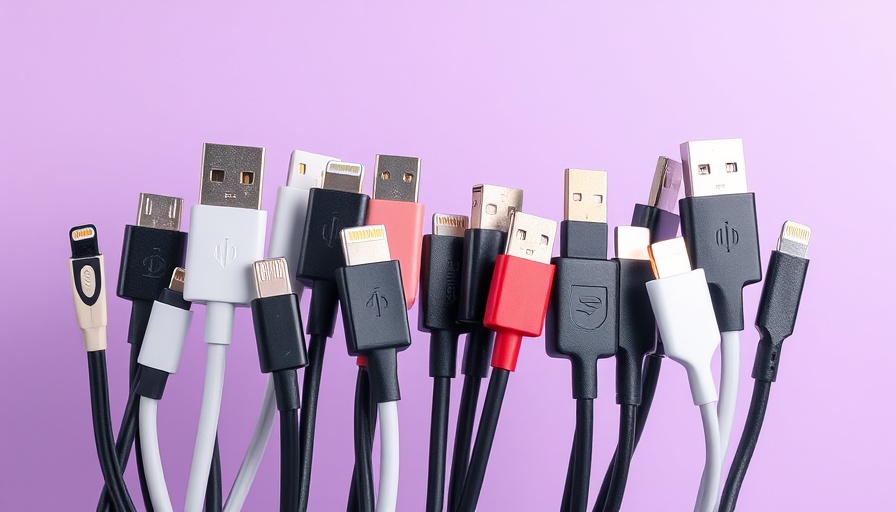
Your Ultimate Guide to Understanding USB Cables
In today’s technology-driven world, USB cables may not always receive the credit they deserve until they become cluttered in a tangled mess within your drawer. Yet, not every USB cable is created equal. With the evolution of gadgets, understanding the differences between USB types has become necessary for homeowners, especially in California where smart home technology is increasingly prevalent. Let’s explore the different types of USB cables, their unique characteristics, and the best use cases for each.
USB-A: The Classic Connection
USB-A is easily recognized due to its larger rectangular shape. Historically, it has been the go-to connection for a plethora of devices including older laptops, televisions, and gaming consoles. While USB-A remains common, it’s not particularly versatile as it is not reversible, often leading to frustrating moments of flipping the cable trying to fit it into the port. Depending on the version, USB-A cables support various speeds, with USB 2.0 maxing out at 480 Mbps, and the faster variants peaking considerably higher. If you are still using older devices, having a few USB-A cables handy is wise, but it’s important to start transitioning to newer standards.
Micro-USB: The Old Standard
Once the primary standard for Android smartphones and other portable devices like Bluetooth speakers and e-readers, Micro-USB boasts a unique trapezoid shape. Unfortunately, its popularity has waned in recent years as manufacturers have shifted towards USB-C. Micro-USB is known for its limited durability due to its tiny internal pins which are susceptible to wear. While it usually supports USB 2.0 speeds, this means it cannot keep up with the faster charging and data transfer demands of today's devices. For California homeowners holding onto older gadgets, consider keeping a Micro-USB cable, but be mindful of transitioning as newer models emerge.
USB-C: The Future of Connectivity
USB-C is rapidly becoming the industry standard and for good reason. This cutting-edge cable not only adds the advantage of dual-sided usability but also supports multiple functions: charging, data transfer, video, and audio. It’s currently utilized in many contemporary devices, from Android phones to laptops and gaming consoles. Depending on the port and cable quality, USB-C can deliver speeds up to 40 Gbps with variants like USB4 and Thunderbolt 4. A crucial point to note: not all USB-C cables are created equal; some may only support charging, while others might not provide full-speed data transfer. Consumers in urban and suburban areas of California should prioritize investing in trustworthy USB-C cables to keep up with their tech needs.
Mini-USB: The Forgotten Connection
Mini-USB, the 'grandparent' amongst USB connectors, was once essential for devices like digital cameras and MP3 players, yet its presence in new technology is scarce. This chunkier connector resembles the Micro-USB but is larger and doesn’t support the same speed capabilities. While you might still find a few devices utilizing Mini-USB, it’s advisable to hold onto those cables as they become increasingly difficult to source.
Lightning Cables: The Apple Exclusive
Lightning cables are Apple's proprietary connecters specifically designed for their ecosystem. Used in devices such as iPhones and iPads, these cables are slim and reversible, allowing for easier connections. However, they tend to lag behind USB-C in both charging power and data transfer capabilities. As Apple transitions towards USB-C in their latest offerings, the importance of Lightning cables may decline, making it a pivotal time for users to evaluate their options.
The Downsides of Outdated Cables
Maintaining and using outdated cords can lead to frustration and potential damage. They often lack essential safety features, and the risk of overheating or poor connectivity can escalate. It’s worthwhile for homeowners to systematically review their collection of cables, discarding those that no longer serve a purpose while optimizing for modern connections.
Future of USB Cables: What’s Next?
As technology continues to progress, the future of USB cables looks promising but complex. With USB-C setting the stage as the standard, we may see innovative cables capable of supporting high-speed connections for more devices in the Internet of Things (IoT). Homeowners should keep abreast of these developments, ensuring their households evolve with the technology trends.
Practical Tips for Homeowners
To manage and organize your USB cables effectively, consider investing in cable management solutions such as organizers and labeling systems to reduce clutter. Keeping an updated inventory can help you quickly locate the right cable when you need it, thus preventing unnecessary purchases. Additionally, knowing which cables support fast charging versus standard charging can help you optimize your device usage.
Engage with Your Technology
As a California homeowner, staying connected effectively is essential. Understanding the pros and cons of different USB cables not only empowers your relationships with technology but also enhances home productivity. Explore gadget compatibility ratings and cable speeds before making your next purchase to ensure you always have the right gear at your fingertips.
 Add Row
Add Row  Add
Add 




Write A Comment